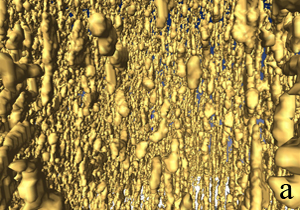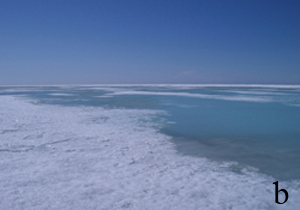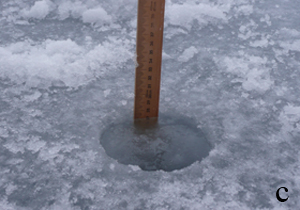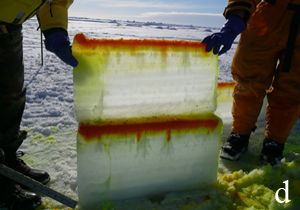Fluid flow through sea ice
Polar sea ice is an indicator and regulator of climate change. Its presence greatly reduces solar heating of the polar oceans by reflecting incoming radiation, while its thinning and retreat show the effects of global warming. Sea ice is also a primary habitat for algal and bacterial communities, sustaining rich marine food webs. The fluid permeability of sea ice - how easy it is for brine or sea water to flow through the ice - is important to many problems in geophysics and biology, yet has remained poorly understood. We have developed a unified picture of sea ice permeability, combining analytical and numerical modeling, comparisons with laboratory and Arctic field measurements, and X-ray computed tomography of sea ice pore microstructure. Our work has been used in developing more realistic representations of sea ice evolution in climate and biogeochemical models. On the SIPEX expedition in 2007, we made the first measurements of fluid permeability in the Antarctic sea ice pack, and observed tracers moving through blocks of sea ice. During the SIPEX II expedition in 2012 we focused on measuring the fluid permeability of granular sea ice, and developing a method for making field measurements of the effective complex permittivity of sea ice in the low GHz regime relevant for satellites.




The brine microstructure of sea ice (a) controls its fluid permeabilty, while the permeability constrains processes important to climate such as the drainage of Arctic melt ponds (b) and the formation of snow-ice, as well as processes which are critical to sustaining microbial life, such as nutrient replenishment. We measure the permeability of sea ice by taking a core partially though the ice and then measure how quickly the water level rises in the hole (c). Here the water is about to flood the surface of the ice, a common situtation in the Antarctic. By pouring a tracer like fluorescein over inverted sea ice blocks (d), brine channels and structural transitions in the ice are exposed.
Some relevant papers (from Publications):
38. K. M. Golden, S. F. Ackley and V. I. Lytle, The percolation phase transition in sea ice, Science, 282, pp. 2238-2241, 1998. PDF
40. K. M. Golden, Brine percolation and the transport properties of sea ice, Annals of Glaciology, 33, pp. 28-36, 2001. PDF
42. K. M. Golden, A. L. Heaton, H. Eicken and V. I. Lytle, Void bounds for fluid transport in sea ice, Mechanics of Materials, 38, pp. 801-817, 2006. PDF
43. J. Zhu, A. Jabini, K. M. Golden, H. Eicken and M. Morris, A network model for fluid transport in sea ice, Annals of Glaciology, 44, pp. 129-133, 2006. PDF
45. K. M. Golden, H. Eicken, A. L. Heaton, J. Miner, D. Pringle, and J. Zhu, Thermal evolution of permeability and microstructure in sea ice, Geophysical Research Letters, 34, L16501, doi:10.1029/2007GL030447, 6 pages and issue cover, 2007. PDF
47. K. M. Golden, Climate change and the mathematics of transport in sea ice, invited article for the Notices of the American Mathematical Society, Volume 56, Number 5, pages 562-584 (including issue cover), May 2009. PDF (Additional References, PDF)
48. D. J. Pringle, J. E. Miner, H. Eicken, and K. M. Golden, Pore-space percolation in sea ice single crystals, Journal of Geophysical Research (Oceans), Vol. 114, C12017, doi:10.1029/2008JC005145, 14 pages, 2009. PDF
73. K. M. Golden, A. Gully, C. S. Sampson, D. J. Lubbers, and J.–L. Tison, Percolation threshold for fluid permeability in Antarctic granular sea ice, preprint, 12 pp., 2016. ABSTRACT


